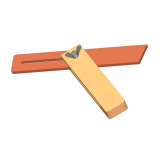Here you can find a plan according to which you can make a sliding bevel square which can also be found under the name sliding T-bevel.
The Sliding bevel square is in reality a try-square with movable blade. The sliding T-bevel is, both for its purpose and appearance, essentially similar to the bevel square tool, the only difference is that the blade protrudes from both sides of the stock so that two angles are available. If the angle on one side is 45°, then it is 135° on the other. The sliding T-bevel serves to mark lines at an angle or to check angles. Sliding T bevel square may be set at any desired angle.

40mm (1.57'') x 43mm (1.69'') x 280mm (11.02'')
Sliding T bevel consists of a stock (or handle) and a slotted blade (or tongue) that pivots on a machine screw with wing nut. The blade may be fixed firmly at any desired angle by simply turning the wing nut (or knurled screw). Use the dimensions in the plan as guidance; in case you need some dimensions that are different from those given in our plan, simply adjust the sliding T- bevel to the dimensions that suit you.


How to use: The best method of setting sliding T bevel is to lay it on the protractor and then set and fix it at the required angle.
This tool is used for:
- checking whether the angle between two surfaces is the same everywhere;
- marking out any angle other than an angle of 90° (for which the try square is used);
- checking all angles except an angle of 90°(for which the try square is used).
About how to use the sliding T-bevel read more here: How to use Sliding T bevel
The blade can be made either of wood or of metal, but if you want a quality and long lasting sliding T-bevel, it is better to use metal for the blade and hardwood for the stock.